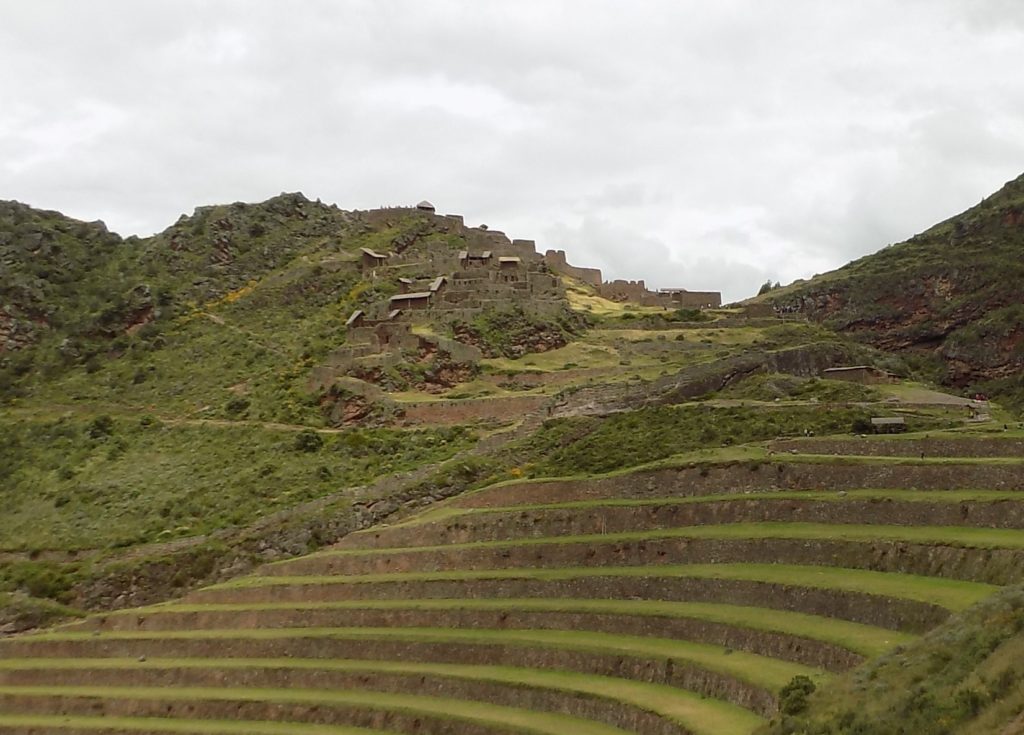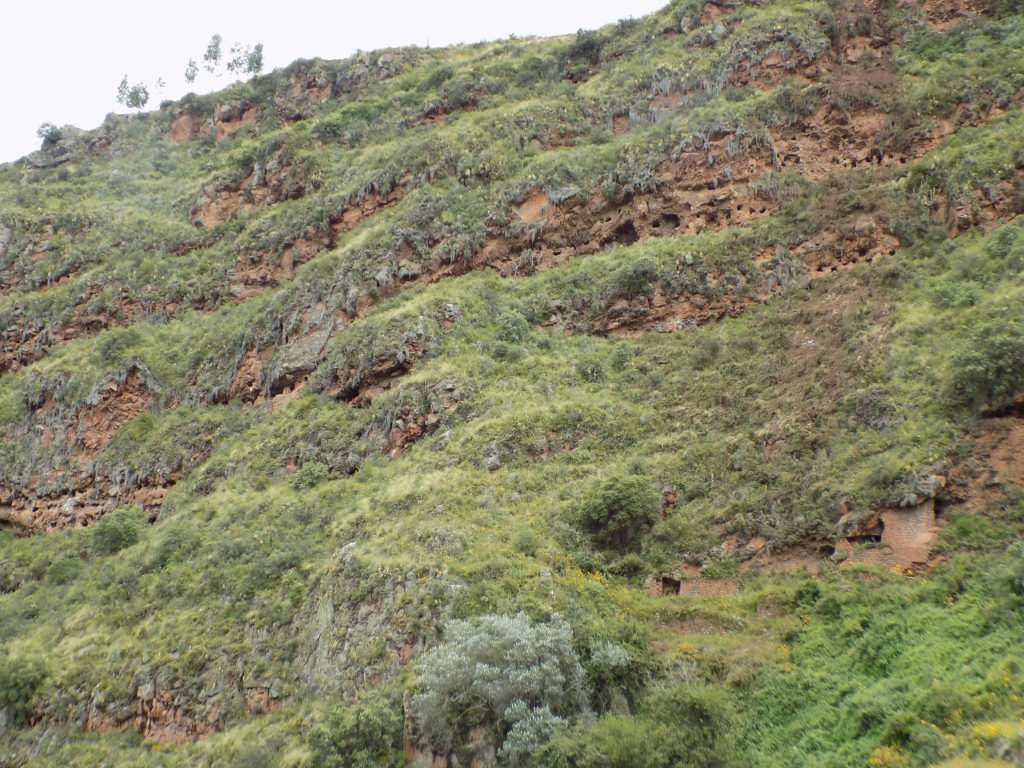Pisaq – Fighting the urge.
One of the leitmotifs of this journal is, “We don’t know.” Pisaq is another case in point (or counterpoint). No one really knows precisely why or when Pisaq was built.
The general consensus for the date of construction settles sometime in the middle of the 15th century. I overheard one guide speculating that the rough construction and some use of adobe shows that some of the structures were built before the arrival of the Inkas. This isn’t necessarily the case. Most Inkan construction didn’t use ashlars and it wasn’t uncommon for the Inkas to use local stones and adobe for local building.
There are at least two hypotheses about Pisaq’s use and construction but flaws (or gaps) are evident in both.
One says that it was ordered built by Pachakutiq who constructed a royal estate to mark each of his military triumphs. If this is the case Pisaq would likely have commemorated a victory over the Cuyos who were one of the first ethnic groups he conquered.
The large terraces that would have been able to provide ample food for any royal entourage lend some credence to this idea. However, what’s missing is evidence of any royal housing for the king.
The other hypothesis says that it was a pukara or citadel community built particularly to protect Cusco from any invaders who might break through a string of pukaras and reach the southern end of the valley.
While the height of the settlement above the valley floor partially supports this notion its size seems to undermine it. Pisaq has four distinct neighborhoods. Needing to protect so much territory effectively weakens using the ridge as a barrier to invasion.
The buildings in the photo above would be the area called Q’allaqasa one of four main archaeologically designated “neighborhoods.” The other three are P’isaqa, Intihuatana, and Kinchiraqay. The Quechua word pisqu means bird and other translations say that p’isaqa means partridge leading some say conclude that Pisaq is bird shaped.
(The lowest part – Fuentes Q’allaqasa – where I spent most of my time – is 3,455 meters above sea level. Still slowed by the altitude, I passed through the Amaru Punku or Serpent’s Gate but I didn’t make the full ascent nor did I visit the Intihuatana. The latter is the religious center of the city and houses both a sacred stone and a Temple of the Sun whose construction is said to echo that of Qoricancha in Cusco.)
Even with the outline clearly delineated, I can’t quite see the bird but perhaps you can in this image from the site tampu-tocco.com.
One aspect of the construction is indisputable whether you see the partridge or not. The Inkas used the contours of the surrounding landscape here as they did elsewhere throughout the Tawantinsuyu and nearly all historians agree that the complex was conceived as an aesthetic whole. You can see the rest of my photos here.
If this isn’t enigma enough, there’s another facet of this site that intensifies Pisaq’s mysteries.
This area is called Tantana Marka or Steeps of lamentation. What you see chiseled into the side of the cliffs is a cemetery estimated to have 3,500 Inkan tombs. This makes it the largest known Inkan cemetery in Peru. The occupants of these graves are likely nobles. As it is at other grave sites we’ve seen, the people were interred in a fetal position. The graves were undisturbed until the end of the 19th century.
And finally, a bit of Inka lore. Near Pisaq there’s a natural formation called Ñusta Encantada (Enchanted Princess). Although I didn’t see the rock, I’m going to retell the myth because it might have familiar echoes.
The tale starts with a beautiful woman named Inqill Chumpi. Her very protective father was a man named Wayllapuma who was the village chief. One day he announced that she would only marry someone who could build a bridge over the Wilkamayu River in a single day. Of course, many of the men of the town tried and, of course, they all failed at this seemingly impossible task.
As men tried and failed, Inqill Chumpi met and fell in love with an Inkan prince named Asto Rimac who started building the bridge early one morning. Inqill Chumpi asked the Apus or mountain spirits to help him. They agreed but only on the condition that she not look at the bridge until it was complete.
The day grew close to sunset and the roar of the thunderous work grew ever louder. She gave in to temptation and turned to see the bridge which was not yet finished. The Wilkamayu rose up and swallowed Asto Rimac and the Apus turned Inqill Chumpi to stone in the spot where she still stands today looking toward the valley.)
There’s a path from the town at the floor of the valley leading up to the ruins and, if one were reasonably acclimated to the altitude, I think it would be a worthwhile climb culminating with a fascinating exploration of Inkan ruins that could be every bit as impressive as those at Machu Picchu. Of course, one would need to spend the entire day to complete the task, which was more time than our tour allowed.
And now the cuy.
For people living in the high Andes, finding and procuring consistent sources of protein was – and to some degree still is – a significant problem. There were some plant sources such as coca leaves that offered some protein but their use was generally ceremonial and often restricted to the upper classes. The main plant-based source was the one the Inka are believed to have called chisiya mama (the mother grain) and is the one we call quinoa. (Quinoa actually has about 25 percent less protein per 100 grams than coca leaves but it has more varieties, is easier to grow, and shares none of coca’s other effects.)
Finding animal-based protein was even more problematic. The two domesticated camelids were considered too valuable in other ways to be widely consumed. (Alpacas were too small to be pack animals but were highly valued for their wool. Their consumption was limited to the elite. Llamas were critical pack animals. It’s possible they were butchered when they were no longer able to serve that purpose. When it was procured, their meat was sometimes dried in strips called charqui and if you see a connection to the English word jerky, congratulations. A third camelid, the guanaco is wild and rare making it unreliable as a protein source.)
There was, however, an animal that was easily domesticated, bred rapidly, and provided a significant source of protein. The animal called in Quechua quwi more commonly transliterated as cuy. In English, we call it guinea pig. It was widely consumed by the Inkas and is still common in Peruvian cuisine today.
I’d been making rather a nuisance of myself with Berner about trying cuy and it’s the other reason I wanted to visit the restaurant in Cusco that Carlos had suggested (Kusi Kuy).
Perhaps because cuy is considerably more expensive in the cities than in the country, Berner had us wait until we reached a roadside strip of cuyerias where men stood displaying their establishment’s cuy al palo.
Even at these roadside stops, presentation of the cuy becomes something of a cook’s display
before it’s taken away and chopped into smaller more manageable pieces. (The skin was chewy and tough but no it didn’t taste like chicken. However, as someone who for more than 40 years has eaten flesh almost exclusively from fish, seafood, and poultry I have little basis for comparing it to something else so don’t ask.)
In Cusco, the display was even more festive as this photo Jill took at Sumkacha shows.
It was late afternoon and we didn’t want to overfill ourselves so we invited our driver to join us and we five shared the plate. Berner, who has eaten cuy all his life, asked permission to eat the head – a proposal to which Jan, Jill, and I happily and immediately consented.
Next stop, Ollantaytambo.





